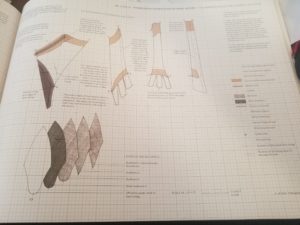Today I’m going to talk about my new precious: PATTERNS OF FASHION 5: THE CONTENT, CUT, CONSTRUCTION & CONTEXT OF BODIES, STAYS, HOOPS & RUMPS c.1595-1795 by JANET ARNOLD, JENNY TIRAMANI, LUCA COSTIGLIOLO, SEBASTIEN PASSOT, ARMELLE LUCAS & JOHANNES PIETSCH.

Cover
This is the fifth volume of the Patterns of Fashion series, and was recently published by the School of Historical Dress. It includes patterns for 26 pairs of stays, a farthingale, 10 hoops and a rump. And it’s AMAZING. Sadly, I believe it’s also sold out and I don’t know if they’re planning on doing a second printing.
In case this series isn’t familiar, Patterns of Fashion is one of the most influential book of historical clothing studies every produced, and Janet Arnold was basically a goddess among women. Her books set the standard for clothing studies, and the people she trained are doing a great job of carrying on her work.
Just leafing it through it, I encountered information I’d never seen before in my 40+ years as a historical re-enactor and costumer. This is absolutely the best part of research, and fills me with delight. I also confirmed what I’d always thought about 17thC stays, but had never been able to find the resources to confirm (that they are in fact often built into the gowns, especially in the first half of the century).
So, what was new? Metal hoops! I’ve seen cane and reed and rope and all kinds of other stuff used, but I’d never seen metal ones in the 18thC. They appear to be very large and are most likely for a court gown (which would need the extra support). And yes, these are still collapsible.

Metal Hoops, c. 1760-1780 (German)
Here are several examples of 17thC gowns with the stays build in (or with the gown bodice boned, if you prefer). I find the Dutch ones particularly fascinating with their fancy frill. They act as stays and stomacher both.

Boned Bodice, c. 1645-1655 (English)

Boned bodice, c. 1630-1635 (Dutch)
Here is also another example of pregnancy stays, which I get asked about quite a bit at conferences. This pair has two stomachers, so basically the lady is wearing her regular stays, but adapting them to her changing figure. I’ve also seen a gown that was adapted this way in the 18thC, so this must have been a common solution.

Reproduction of pregnancy stays, c. 1665-1675 (English)
And here’s a great example of why these books are so valuable to anyone who wants to make or understand historical clothing. First, the put stuff into a larger context in the front of the books:

Detail page about Reisser & Garsault books about stay making. 18thC. French.

Information about taking measurements and construction, also from Reisser & Garsault. 18thC. French.
Then they offer details of the extant garment:

Details of extant strapless stays, c.1760-1770 (English)

Details of extant strapless stays, c.1760-1770 (English)
Then they have a diagramed study with even more details:

Diagram of extant strapless stays, c.1760-1770 (English)

Diagram of extant strapless stays, c.1760-1770 (English)
In short, this is my favorite series of books ever, and I can’t wait to see what the Historical School of Dress puts out next.


















